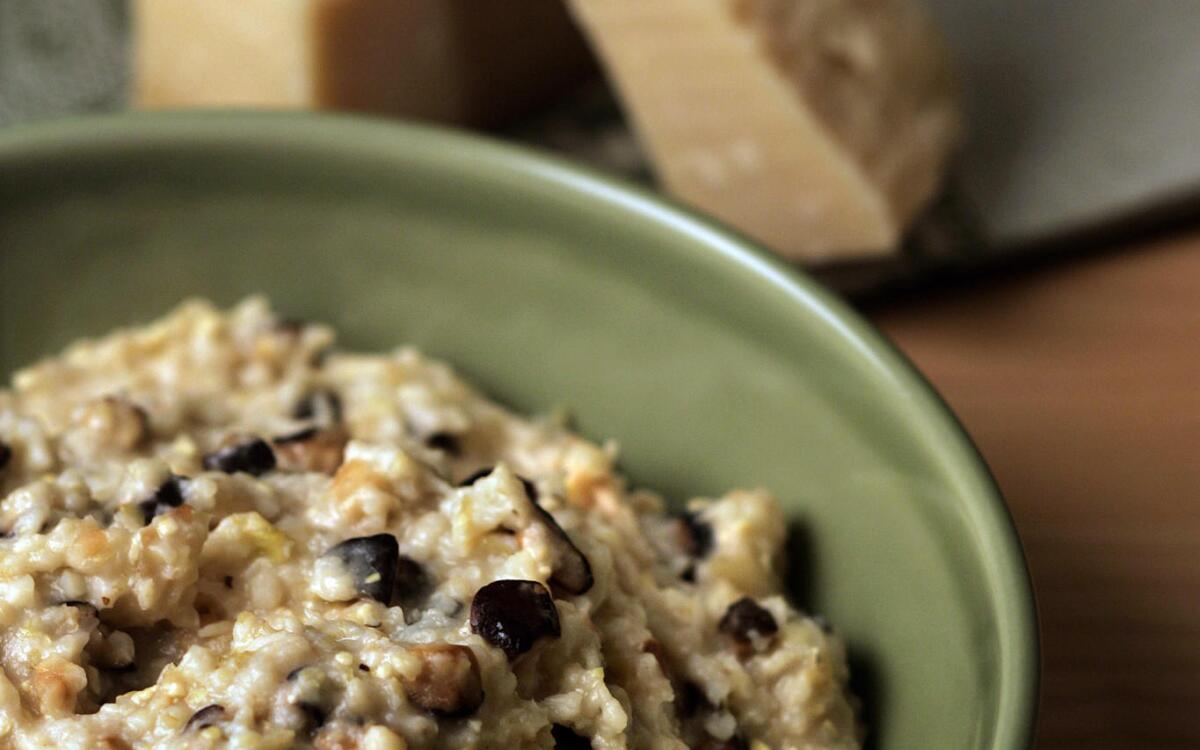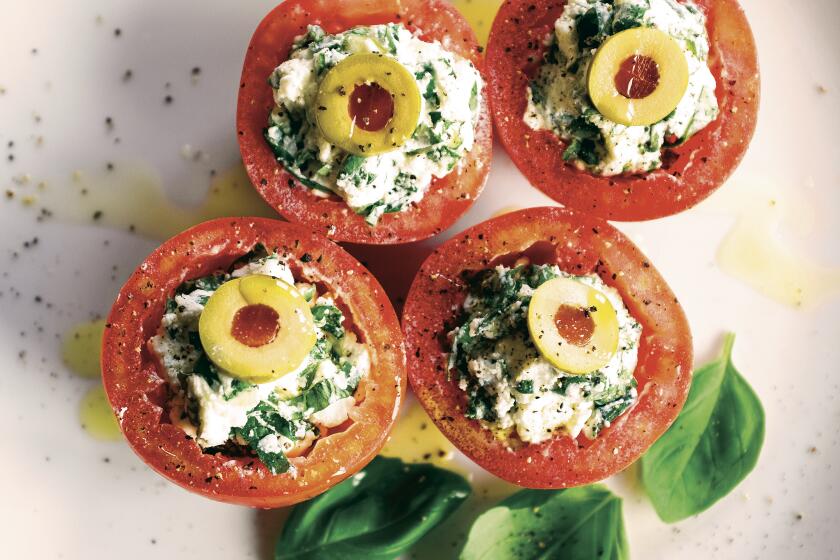Grits with leek and shiitakes

- Share via
Six years ago this spring I ordered a fish for its side dish in a restaurant in Charleston, S.C., and I have not been the same since. What was described simply as “creamy grits” on the menu was beyond a revelation. These were golden, slightly nubbly and vibrant with corn flavor. Creamy was beside the point.
Back then, about the only way to have that transporting experience was at the source, deep in the South where grits originated. The rest of America was mostly sentenced to supermarket grits, white and smooth and as gutsy as Cream of Wheat. Even if you bought the “old-fashioned” kind from Quaker, the best you could hope for was one step better than gruel.
Now real grits are easily available, in stores and online, and the only wonder is why chefs are not making more of them. Mix grits with buttery leeks and shiitakes and you will never settle for mashed potatoes again. Serve them with duck or shrimp or sausage and you may give up rice. Real grits have such distinctive flavor you can only marvel at how many nuances a single ingredient can have: a little like popcorn, a little like roasted corn on the cob, a bit sweet like corn pudding.
Grits have cachet. They have character. Essentially, they are the William Hurt of starches: Give them a supporting role and they will steal the show.
As with so many other improvements in ingredients lately, whether artisanal cheese or heritage turkeys, the grits upgrade actually represents a step backward. Producers who have revived or stuck to the old way of growing corn, drying it and grinding it to bits, are now marketing a time-honored product that suddenly tastes completely new.
Refinement was just not good to grits. One of the greatest concepts in American cooking has been milled away over the last half a century, to the point that most people hear the word and can only think of diner porridge. But real grits are more like sand and gravel than powder and dust when raw; they need serious cooking, and when they are done they are still almost chewy, in the best way. They are also more nutritious because they have not been processed to instant pabulum.
Glenn Roberts, who founded Anson Mills in South Carolina in 1998, refers to them as antebellum grits, meaning the extremely coarse kind that were routinely produced until the end of World War II. They have a sweeter flavor from the corn, which he notes starts with “high mineral, floral notes.” The finer the dried kernels are ground, the more flavor they lose along with the texture that should define them.
Authentic grits might be labeled coarse, old-fashioned or stone-ground. Speckled Heart is a trademarked term for grits with flecks of color in them. As Roberts points out, corn comes in many hues beyond white or yellow, including blue, red, even black. What sets all grits apart from polenta, or cornmeal, are the size of the grains and the type of corn used (flint for polenta, dent for grits).
Grits are probably most associated with breakfast, and there’s no denying they’re great with eggs, bacon, sausage, ham, biscuits and, weird as it sounds, white gravy. In New Orleans they’re a classic eye-opener under grillades, which is veal or beef cooked in a lively sauce.
But authentic grits can be dressed up for dinner too. They have an affinity for earthy, smoky flavors: shiitakes, leeks, chipotles, smoked paprika. Garlic is the most typical value-added flavoring, but chives, basil or roasted red peppers can also give them a sophisticated edge.
Grits go with everything Southern and Southwestern and some things French: andouille sausage, shrimp, crab, chilies, beans, omelets and especially duck confit.
And while they don’t need dairy to taste creamy, they won’t turn it away, either. Sharp cheddar, Gorgonzola, Parmigiano-Reggiano and even pepper Jack all round out the corn flavor.
Anson has become a buzzword for artisanal grits around the country, but Callaway Gardens in Georgia produces excellent Speckled Heart grits. Those are the two brands most widely available, although a few smaller mills around the country also produce old-fashioned grits.
Locally, Anson’s are sold at Silverlake Wines and at Surfas (at the latter, the store buys them in bulk and packages them as “coarse white grits” in Surfas plastic jars). Speckled Heart grits from Callaway Gardens Country Store are sold online by www.foodlocker.com; the minimum order is three 2-pound bags for $19.99 including shipping.
*
Simmer and stir
These are not grits to boil up in five minutes or less. Anson’s coarse-ground grits need up to two hours of simmering over very low heat, while Speckled Heart grits take at least 30 minutes. Anson’s can be soaked overnight to cut the cooking time in half and, coincidentally, improve both the flavor and, Roberts says, the nutritiousness thanks to fermentation, which changes the starch character.
Unlike polenta, grits do not get clumpy and lumpy, but they do need steady stirring. Grits are also more forgiving -- if they start to dry out, you can just add more water (or milk or cream) and keep cooking until the texture is just the way you want it. They are unpredictable, though. The general rule is 1 part grits to 3 to 4 parts water, but depending on the day and the grits, you have to be flexible in adjusting the liquid and the cooking time.
(One more reason for cooking over low heat is to reduce the risk of encrusting the pot with something even stickier than spackle. Use a heavy-bottomed saucepan; an enameled iron one that resists sticking is a good choice.)
The dictionary says the name “grits” comes from the Middle English word for gryttes, for something crumbled or rubbed hard. Anson’s Roberts contends that it stems from hominy grist, grist being what is left of any grain after grinding. Hominy is dried corn that has been treated with slake lime or potash to remove the germ and hull, a process that gives it a taste somewhat similar to masa.
Roberts says hominy grits are now very rare, although “hominy” has started turning up on restaurant menus lately, probably because it is so much more euphonious.
Authentic grits are actually perishable. They have to be stored in the refrigerator or freezer because they retain enough oil in the corn to turn rancid. Anson’s are particularly fresh -- they are produced entirely by hand, in small batches, from corn that it grows organically. “We mill Monday, Tuesday, Wednesday and farm Thursday, Friday, Saturday,” Roberts says. Grits in the familiar round box, by contrast, can probably last through a nuclear winter in a cupboard.
Because they are anything but ephemeral, ordinary grits are most often thought of as a vehicle for dairy, particularly butter and cheese. The real deal need only salt and pepper. The flavor and texture are so exceptional, even cream is beside the point.
In a heavy saucepan, bring 4 cups water to a rolling boil with 1 teaspoon salt. Add the grits and stir until smooth. Lower the heat to simmer and cook, stirring often, until the grits are tender and cooked through (1 to 1 1/2 hours for Anson Mills grits). Add more water if the mixture gets too thick and dry.
While the grits cook, melt 1 tablespoon of the butter in a large skillet over medium heat. Add the garlic and leeks and sprinkle with about one-fourth teaspoon salt. Cook, stirring often, for 5 minutes. Add the remaining butter and the shiitakes and continue cooking and stirring for 10 minutes. Stir in the tamari or soy sauce and the Tabasco.
When the grits are cooked, add the leek mixture and mix well. Taste and adjust the seasoning. Stir in the Parmigiano-Reggiano and serve.
Get our Cooking newsletter
Get a taste of Los Angeles — and the world — with recipes and kitchen tricks from the L.A. Times’ Cooking newsletter.
You may occasionally receive promotional content from the Los Angeles Times.















